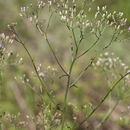Comprehensive Description
provided by North American Flora
Vernonia cinerea (L) Less. Linnaea 4: 291. 1829
Conyza cinerea L. Sp. PI. 862. 1753.
Cacalia cinerea Kuntze, Rev. Gen. 323. 1891.
Seneciodes cinereum Kuntze; Post & Kuntze, Lex. Gen. Phan. 515. 1904.
Stems herbaceous, erect, simple or freely branched, 1-8 dm. high, glabrate below, cinereous-pubescent above; leaf-blades thin, bright-green, spreading, variable in shape from narrowly elliptic or oblanceolate to broadly ovate or triangular, 2-5 cm. long, acute or obtuse, serrate, crenate, or entire, abruptly constricted at the base into a margined petiole, cinereous-pubescent beneath; inflorescence corymbose, 2-10 cm. wide; braeteal leaves subulate; heads about 13flowered; involucre campanulate, 3-4 mm. high; scales loosely and irregularly imbricate, thinly pubescent, the outer subulate, the inner linear-oblong, acuminate, purplish at the apex; achenes pubescent; pappus white, the inner series 5 mm. long, the outer minute.
Type locality: India.
Distribution: Tropics of the Old World; introduced throughout tropical America as far north as Mexico and southern Florida.
- bibliographic citation
- Per Axel, Rydberg. 1922. CARDUALES; AMBROSIACEAE, CARDUACEAE. North American flora. vol 33(1). New York Botanical Garden, New York, NY

